Evaluating a horse's back for saddle fit - part one
We are no longer building saddle trees, but we have two videos about how Western saddles fit horses available on our westernsaddlefit.com website.
When we look at a horse in real life or look at pictures of horses that people send us, we don’t just look at the whole back and say “look at that whole back!” Just as there are Factors That Affect Tree Fit, we can break down the horse’s back into specific factors that we need to fit. We evaluate these individually and then put them all together to get a more accurate picture of the whole back. I can see this topic taking three posts to cover, so here’s part one.
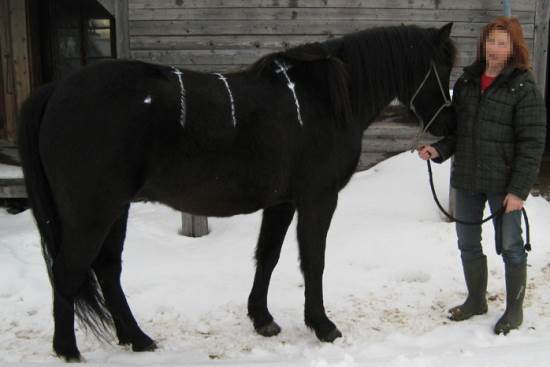
The first thing we look at is a side view of whole horse. What we are wanting to learn initially is the overall size of the horse. If we can’t see the horse for real, getting height and weight estimates of the horse are helpful, but having a person in the picture for scale is ideal.
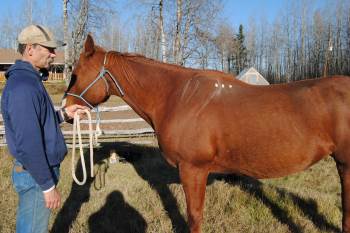 |
Now, we do need to know something about the person in the picture too. The horse in the picture on the left doesn’t look to be overly tall - until you know that the owner is about 6’ 4”. Compare that to the picture on the right where we know that Rod is 6’ tall and Dancer is about 16 hands. That changes the size perspective a little… The overall size is one component we use when figuring out what bar spread is needed. More on that in the next post in this series.
Another thing we try to get a feel for from viewing the horse from the side is the overall length of the back. Again, knowing the size of the horse overall is really helpful in evaluating how long the back is. We can usually see the back of the shoulder blade and the hip. Measuring the shoulder to hip distance is something that can be done for more information, but even in looking at pictures we can get a general idea if bar length might be a concern or not for the horse. It is obvious in looking at these two pictures that we won’t have to worry about bar length on the grey, but we will need to consider it on the pinto.
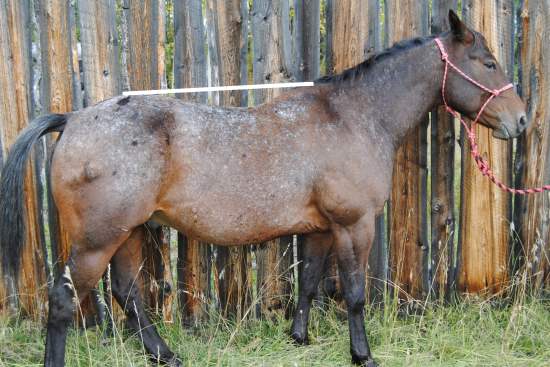
Something else we look at when viewing the whole horse from the side is how level or “downhill” the back is. Now, there are many ways people look at horses to decide if they are “downhill” or not, and since “downhill” isn’t a technical, scientific term, I don’t think there is a correct way to do this. The most common is evaluating croup height and wither height. But a saddle doesn’t sit on either the croup or the withers, and withers can be tall or short relative to the body. So that isn’t overly helpful to us as tree makers when we are trying to figure out how the bars will sit on the horse’s back.
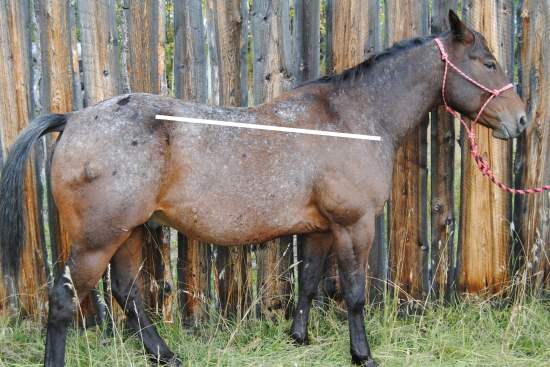
Another way I have only read about in certain circles is trying to imagine the bone structure and connect the point of hip to the lower cervical vertebrae. Evaluated this way, basically all horses are “downhill”. While this may or may not be useful in judging conformation, the saddle doesn’t sit on the point of the hip or the neck, so it is not helpful for figuring out saddle fit either.
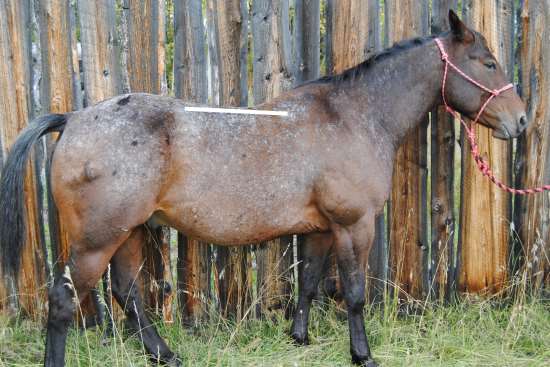
So where do we look? The part of the back that is under the bars, of course!! That is where the saddle will sit, so that area is what is practical for us as tree makers. How level or “downhill” (tilted forward) is that section of the back?
To see where that area is, imagine a line under the center of the bar running from front to back. That is where we are looking to see how level the back is for our purposes.
Here’s a horse that is very level along his back where the bars go. Note that he is not a Quarter Horse. Interesting... (You can also see that he is a tall horse just compared to the people in the picture.) Croup to withers go uphill a fair amount, but his back is level.
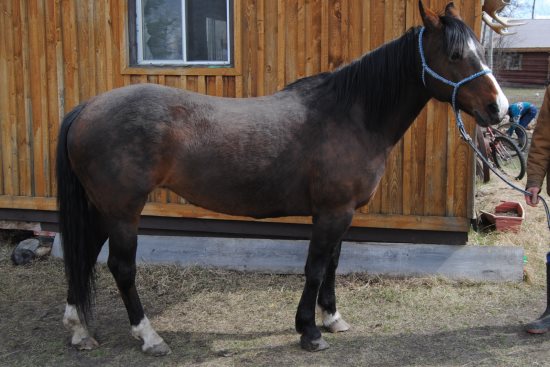
This is what we see most commonly - a slight downward tilt toward the front of the horse. The croup to withers still go uphill on this horse, but the back where the bars go is slightly downhill.
I believe that we see this most commonly in North America because we most commonly see quarter horse types, and quarter horses are bred to have big hind ends. People whose “normal horse” is not a quarter horse type will see something different as their most commonly seen horse. (I tried to figure out where to put in "most commonly" again to make it a full five times, but couldn't quite do it...)
This is what we would call a “downhill” horse. Although his croup and withers are pretty much level, when you look at his back where the bars go, it runs downhill a fair amount. We see this body type quite commonly, and these horses can have more issues with saddles interfering with the shoulder if they don’t fit well.
This horse is what we would call very downhill. (Both pictures are of the same horse, so you can see how differently a horse can appear depending on how they are standing, their environment, etc.) Now, first thing when you see this is to check the age of the horse. If the horse is still growing (less than 5 years old) it may be a temporary condition and the front will catch up to the hind eventually. (Disclaimer, unless you ride a lot of colts, you need to be careful in getting a saddle that will fit a youngster because backs change as a horse becomes mature.) But this was a mature horse and he wasn’t going to change.
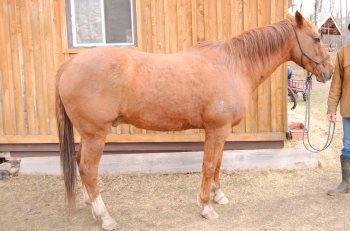 |
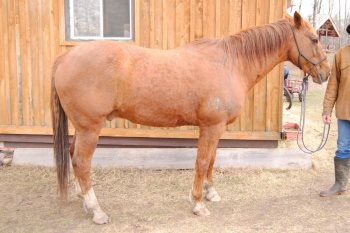 |
If you are looking at pictures only, you also have to be aware of how easy it is to tilt the camera a little. It is always nice when there is a fence or trees or a building behind the horse in a picture so we can see if the picture is tilted or not. (Just an aside - this is also something to check out if you are looking at pictures when purchasing a horse. I’ve seen a few where the background is obviously tilted to make the horse look more level than he is.) It is also good to be able to see the horse’s feet in these pictures so you know if they are standing on a slope or not.
So, how does the “downhillness” affect what we do with the tree? It doesn’t really. We can’t change the horse and we can’t change gravity (which always works), so these horses will always be more prone to having the tree move too far forward on them if the saddle doesn’t fit well.
We have heard some theories on how you can get the tree more level on a really downhill horse. One is to spread the back of the bars farther apart so they sit lower on the back. The problem with that is that most horses that are built downhill are pretty level side to side across the loin, and unless you have a really narrow horse, you have to go a long way out before the back of the tree will drop any substantial amount. And then you have to worry about the cantle gullet or ground seat hitting the top of the spine.
Another option would be to narrow up the hand hole width so the front will sit higher on the horse. Well, now you have contact only on the bottom of the front bar pads where the pressure is often highest anyway. No, none of these ways will level out the tree relative to the ground without having negative repercussions for the horse.
So we don’t adjust the way we build our trees when fitting a downhill horse compared to a more level horse. We make sure our customer knows that a downhill horse may have more issues, and then we fit the body shape of the horse so there is lots of contact over a wide surface area to help keep the saddle it place, sort of like two teaspoons fit together. And since we have built trees for both the grey and the bay horses above labelled as being downhill (and many more like them) and have had positive feedback from the owners on how they have worked, we figure we’re already doing the best thing we can for them…
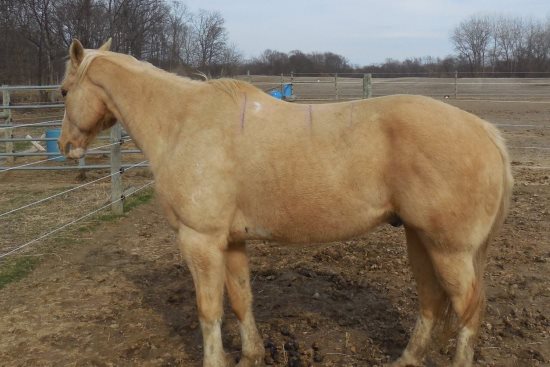
We also look at the withers when we are looking from the side. First thing, how tall are they? Are we going to have to add extra height to the fork in order to clear these withers?
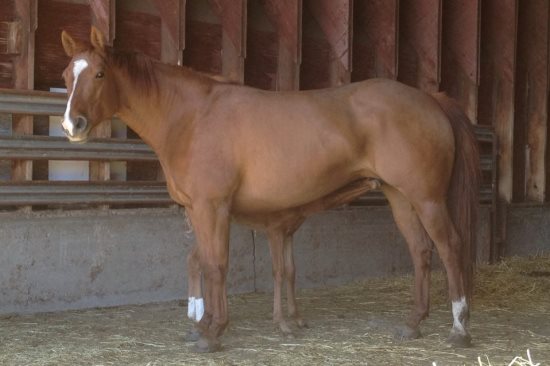
Or is fork style and the use of the saddle (ie. roping) going to be the determining factor in deciding gullet height, since hitting the withers is never going to be a concern?
And how far back do they go relative to the shoulder blade? Since the front of the bar sits right behind the shoulder blade on a western saddle, what happens in front of that doesn’t really concern us. But what happens behind that really does. Both these horses have tall withers, but on the bay, they slope down quickly enough that gullet height will be the concern, not hand hole height. On the palomino, we need to consider hand hole height as well since a lot of that wither will be under the fork. On a horse like this, even the front of the groundseat may be a concern. (And yes, that is a horseshoe on the back of the withers showing the angle as they finally tie into the back.)
So those are most of the things we are initially looking at directly from the side. Next, what we are checking when we look at the horse from the back.
